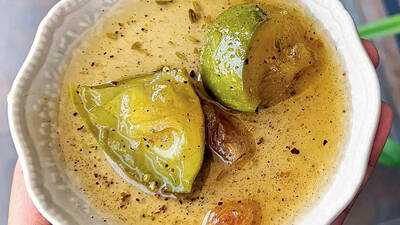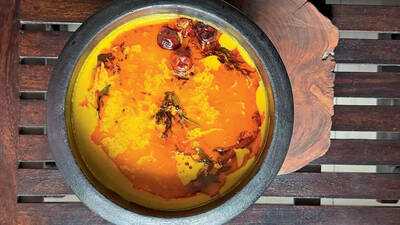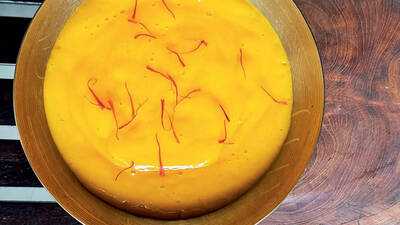From intensely sweet and floral alphonso and kesars to tangy varieties like totapuri and langda, Indian mangoes span a wide flavour profile. They stir senses, spark nostalgia and find a special place in the Indian regional kitchens.
Just as their taste and texture vary, so do their culinary uses, with every region giving the fruit its distinctive twist – from tenderisers in meat curries to desserts, comforting dals, pickles and chutneys that pack summer in a jar.
Adding a tang with kachcha aam
Raw mangoes, prized for their tartness, are a common thread in regional Indian cuisines, used to add freshness, tang and complexity to savoury dishes.
Mamadikaya pulihora
A summer favourite in Andhra Pradesh, mamidikaya pulihora is a tangy rice dish made with grated raw mango, tempered with mustard seeds, curry leaves and green chilies.

Chef Sadaf Hussain, who curated a mango-inspired menu for a recent Bazm-e-Aam event, says, “There’s no other fruit that offers such versatility, from raw to ripe.” His regional spread featured dishes like Gujarat's ras no fajeto, Manipur’s heinou metpa, Andhra's mamidikaya pulihora (mango rice), Bihar's aam ka koocha, and Rajasthan’s kachche aam ki kheer - all celebrating mangoes across India’s culinary map.”
Mango preserves
Mango preserves are a part of many culinary cultures. Be it aam ki launji, galka or gudamba, raw mangoes are used to make sweet-spicy jams across the country. About the culinary use of mangoes in Bihar, chef Nishant Choubey, says, “Gudamba is a chutney-like preparation made from raw mangoes, jaggery and red chillies. It is a mix of sweet and sour with a hint of heat.” The jam-like galka, made with raw mangoes and sugar or jaggery, is a Lakhnawi household favourite, says chef Taiyaba Ali.

Aam bata
In Bengali cuisine, aam bata is a traditional raw mango mash or paste, typically made in the summer. It is prepared by boiling or roasting green mangoes, then mashing them with mustard oil, salt and green chillies.

Achraj
Achraj is a traditional minced-mutton dish of the Awadhi cuisine. It blends finely minced goat meat cooked in aromatic spices and enriched with raw mango, added towards the end for a sharp, tangy finish. In the Awadhi cuisine, chef and writer Taiyaba Ali notes that raw mango is used not just for its flavour but as a tenderiser. “One will see raw mango being cooked with meat, like in Achraj, a qeema and aam dish.” In her recently curated seven-course mango-forward dining experience, Aam Baat, the chef featured a mix of traditional dishes inspired by home-cooked Awadhi food with a twist, like acharaj pulao.

Indulgence with the sweet ripe side
If raw mango adds tartness, ripe mango is all about indulgence. Chef Ashish Bhasin reflects on how mango is deeply rooted in the Indian food psyche “Unlike fruits introduced through invasions, mango is truly ours. Ripe mangoes lend a natural sweetness. Balanced with spices, they create flavours that are deeply Punjabi.
Fajeto
Fajeto is a Gujarati kadhi where the puree of ripe mangoes meets whisked curd and besan. It is slow-cooked with ginger, green chillies, and spices and topped with a generous ghee tempering of mustard, cumin, fenugreek, cinnamon and dry red chilli.

Aamras
Aamras is a silky mango puree made from ripe mangoes, typically flavoured with cardamom or saffron. “Popular in Maharashtra and Gujarat, it’s often served chilled with puris as a summer delicacy.

The mango seed acts as a preservative for aamras and prevents enzymatic browning or oxidation when aamras comes in contact with the oxygen in the air,” shares culinary consultant Reetu Kugaji, adding, “The natural balance of sugar and acidity in mangoes, along with its ability to absorb spices, makes them ideal for traditional sweets like aamras, aamrakhand or mambazha payasam”
Mambazha pulissery
In Kerala, the sweet side of mangoes is showcased in dishes like pulissery, a yoghurt-based curry, where the fruit imparts richness while the yoghurt provides tang. “It’s a balance of sweet and sour that defines summer meals in the south,” adds chef Rakesh Raghunathan.

Amrakhand
Amrakhand, a delicious blend of ripe mango pulp and creamy hung curd, enhanced with sugar, cardamom and saffron. Enriched with blanched charoli seeds, pistachios, almonds; amrakhand is a chilled, fragrant indulgence that captures the soul of Maharashtrian and Gujarati summers

Mango leather
The chewy, sun-dried slices of mango takes on different names across India. It’s known as aam papad in the North, mamidi tandra in Andhra Pradesh, amba poli in Maharashtra and aam sotto in Bengal. Usually made with ripe mango pulp sweetened with sugar or jaggery, some regional recipes add a bit of raw mango for a tangy twist. In Bengali cuisine, too, ripe mangoes shine in festive fare. “We make payesh (rice pudding), doi (mango-infused curd), sandesh, sotto (aam papad) and even enjoy ripe mango with boiled rice,” says Samita Haldar.

Just as their taste and texture vary, so do their culinary uses, with every region giving the fruit its distinctive twist – from tenderisers in meat curries to desserts, comforting dals, pickles and chutneys that pack summer in a jar.
Adding a tang with kachcha aam
Raw mangoes, prized for their tartness, are a common thread in regional Indian cuisines, used to add freshness, tang and complexity to savoury dishes.
Mamadikaya pulihora
A summer favourite in Andhra Pradesh, mamidikaya pulihora is a tangy rice dish made with grated raw mango, tempered with mustard seeds, curry leaves and green chilies.

Chef Sadaf Hussain, who curated a mango-inspired menu for a recent Bazm-e-Aam event, says, “There’s no other fruit that offers such versatility, from raw to ripe.” His regional spread featured dishes like Gujarat's ras no fajeto, Manipur’s heinou metpa, Andhra's mamidikaya pulihora (mango rice), Bihar's aam ka koocha, and Rajasthan’s kachche aam ki kheer - all celebrating mangoes across India’s culinary map.”
Mango preserves
Mango preserves are a part of many culinary cultures. Be it aam ki launji, galka or gudamba, raw mangoes are used to make sweet-spicy jams across the country. About the culinary use of mangoes in Bihar, chef Nishant Choubey, says, “Gudamba is a chutney-like preparation made from raw mangoes, jaggery and red chillies. It is a mix of sweet and sour with a hint of heat.” The jam-like galka, made with raw mangoes and sugar or jaggery, is a Lakhnawi household favourite, says chef Taiyaba Ali.
Aam bata
In Bengali cuisine, aam bata is a traditional raw mango mash or paste, typically made in the summer. It is prepared by boiling or roasting green mangoes, then mashing them with mustard oil, salt and green chillies.
Achraj
Achraj is a traditional minced-mutton dish of the Awadhi cuisine. It blends finely minced goat meat cooked in aromatic spices and enriched with raw mango, added towards the end for a sharp, tangy finish. In the Awadhi cuisine, chef and writer Taiyaba Ali notes that raw mango is used not just for its flavour but as a tenderiser. “One will see raw mango being cooked with meat, like in Achraj, a qeema and aam dish.” In her recently curated seven-course mango-forward dining experience, Aam Baat, the chef featured a mix of traditional dishes inspired by home-cooked Awadhi food with a twist, like acharaj pulao.

Indulgence with the sweet ripe side
If raw mango adds tartness, ripe mango is all about indulgence. Chef Ashish Bhasin reflects on how mango is deeply rooted in the Indian food psyche “Unlike fruits introduced through invasions, mango is truly ours. Ripe mangoes lend a natural sweetness. Balanced with spices, they create flavours that are deeply Punjabi.
Fajeto
Fajeto is a Gujarati kadhi where the puree of ripe mangoes meets whisked curd and besan. It is slow-cooked with ginger, green chillies, and spices and topped with a generous ghee tempering of mustard, cumin, fenugreek, cinnamon and dry red chilli.
Aamras
Aamras is a silky mango puree made from ripe mangoes, typically flavoured with cardamom or saffron. “Popular in Maharashtra and Gujarat, it’s often served chilled with puris as a summer delicacy.
The mango seed acts as a preservative for aamras and prevents enzymatic browning or oxidation when aamras comes in contact with the oxygen in the air,” shares culinary consultant Reetu Kugaji, adding, “The natural balance of sugar and acidity in mangoes, along with its ability to absorb spices, makes them ideal for traditional sweets like aamras, aamrakhand or mambazha payasam”
Mambazha pulissery
In Kerala, the sweet side of mangoes is showcased in dishes like pulissery, a yoghurt-based curry, where the fruit imparts richness while the yoghurt provides tang. “It’s a balance of sweet and sour that defines summer meals in the south,” adds chef Rakesh Raghunathan.
Amrakhand
Amrakhand, a delicious blend of ripe mango pulp and creamy hung curd, enhanced with sugar, cardamom and saffron. Enriched with blanched charoli seeds, pistachios, almonds; amrakhand is a chilled, fragrant indulgence that captures the soul of Maharashtrian and Gujarati summers

Mango leather
The chewy, sun-dried slices of mango takes on different names across India. It’s known as aam papad in the North, mamidi tandra in Andhra Pradesh, amba poli in Maharashtra and aam sotto in Bengal. Usually made with ripe mango pulp sweetened with sugar or jaggery, some regional recipes add a bit of raw mango for a tangy twist. In Bengali cuisine, too, ripe mangoes shine in festive fare. “We make payesh (rice pudding), doi (mango-infused curd), sandesh, sotto (aam papad) and even enjoy ripe mango with boiled rice,” says Samita Haldar.
You may also like

Rahul Gandhi defends Robert Vadra against ED charges, Congress follows suit

Children smuggled to France from UK in reverse Channel migrant crossings

Gogglebox star Rylan Clark's mum Linda rushed to hospital as he cancels work commitment

Prince Harry and Meghan Markle's huge decision on return to UK

Love Island star forced to leave villa in savage bombshell twist - and it's not Harrison






